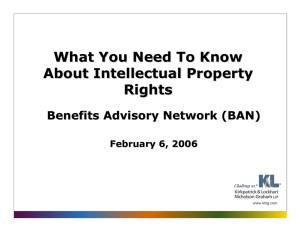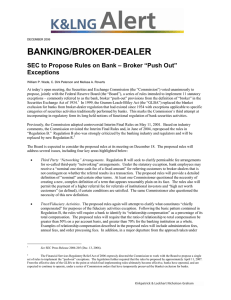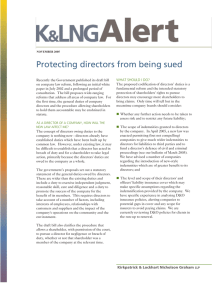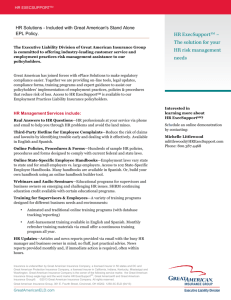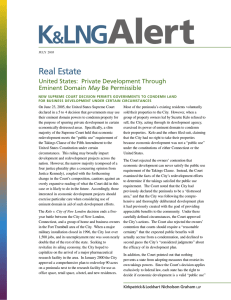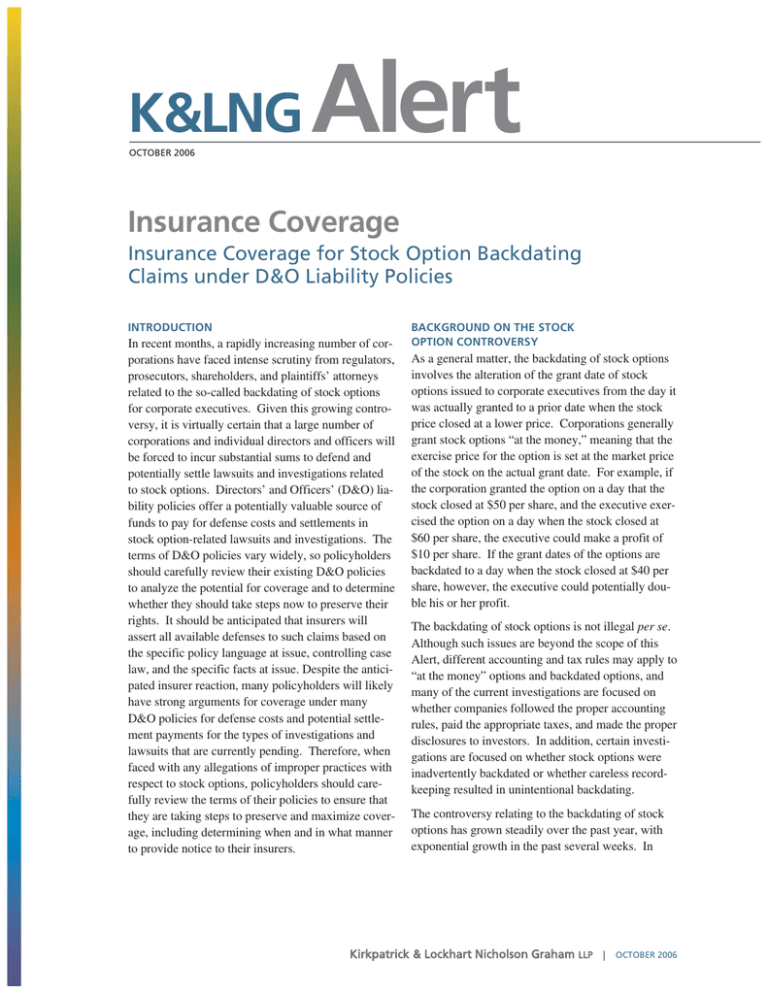
K&LNG
OCTOBER 2006
Alert
Insurance Coverage
Insurance Coverage for Stock Option Backdating
Claims under D&O Liability Policies
INTRODUCTION
In recent months, a rapidly increasing number of corporations have faced intense scrutiny from regulators,
prosecutors, shareholders, and plaintiffs’ attorneys
related to the so-called backdating of stock options
for corporate executives. Given this growing controversy, it is virtually certain that a large number of
corporations and individual directors and officers will
be forced to incur substantial sums to defend and
potentially settle lawsuits and investigations related
to stock options. Directors’ and Officers’ (D&O) liability policies offer a potentially valuable source of
funds to pay for defense costs and settlements in
stock option-related lawsuits and investigations. The
terms of D&O policies vary widely, so policyholders
should carefully review their existing D&O policies
to analyze the potential for coverage and to determine
whether they should take steps now to preserve their
rights. It should be anticipated that insurers will
assert all available defenses to such claims based on
the specific policy language at issue, controlling case
law, and the specific facts at issue. Despite the anticipated insurer reaction, many policyholders will likely
have strong arguments for coverage under many
D&O policies for defense costs and potential settlement payments for the types of investigations and
lawsuits that are currently pending. Therefore, when
faced with any allegations of improper practices with
respect to stock options, policyholders should carefully review the terms of their policies to ensure that
they are taking steps to preserve and maximize coverage, including determining when and in what manner
to provide notice to their insurers.
BACKGROUND ON THE STOCK
OPTION CONTROVERSY
As a general matter, the backdating of stock options
involves the alteration of the grant date of stock
options issued to corporate executives from the day it
was actually granted to a prior date when the stock
price closed at a lower price. Corporations generally
grant stock options “at the money,” meaning that the
exercise price for the option is set at the market price
of the stock on the actual grant date. For example, if
the corporation granted the option on a day that the
stock closed at $50 per share, and the executive exercised the option on a day when the stock closed at
$60 per share, the executive could make a profit of
$10 per share. If the grant dates of the options are
backdated to a day when the stock closed at $40 per
share, however, the executive could potentially double his or her profit.
The backdating of stock options is not illegal per se.
Although such issues are beyond the scope of this
Alert, different accounting and tax rules may apply to
“at the money” options and backdated options, and
many of the current investigations are focused on
whether companies followed the proper accounting
rules, paid the appropriate taxes, and made the proper
disclosures to investors. In addition, certain investigations are focused on whether stock options were
inadvertently backdated or whether careless recordkeeping resulted in unintentional backdating.
The controversy relating to the backdating of stock
options has grown steadily over the past year, with
exponential growth in the past several weeks. In
Kirkpatrick & Lockhart Nicholson Graham LLP |
OCTOBER 2006
May 2005, the controversy was fueled by an academic report published by a business professor at the
University of Iowa, Erik Lie. Professor Lie’s report
identified so-called “pre- and post-grant price patterns” with respect to a substantial sample of options
that suggested that stock prices tended to decrease
immediately before the date on which many corporations granted options. Based on this statistical pattern, the report concluded that “unless corporate
insiders can predict short-term movements in the
stock market,” at least “some of the grants had been
backdated.”1
In turn, Professor Lie’s research “attracted media and
regulatory attention to the problem.”2 For example,
on March 18, 2006, The Wall Street Journal published an article questioning the timing of stock
option grants at UnitedHealth and five other companies.3 Within a few weeks, it was reported that the
SEC and federal prosecutors were investigating
dozens of companies.4 By May 6, 2006, The Wall
Street Journal reported that “at least 10 companies
have been caught up in the stock-option-dating matter.”5 By July 17, 2006, the New York Times reported
that at least 60 companies had publicly disclosed that
they are the targets of government investigations, had
been sued by investors, or had commenced internal
investigations concerning stock options.6 In mid-July
2006, Professor Lie (along with certain collaborators)
published another report suggesting that “more than
2,000 companies appear to have used backdated
stock options to sweeten their top executives’ pay
packages.”7
1
2
3
4
5
6
7
8
9
10
11
12
13
14
2
In September 2006, the SEC testified before
Congress that it was investigating more than 100
companies.8 SEC Enforcement Director Linda
Thompson testified that “as the use of options compensation has increased, however, so apparently has
its abuse…. This practice benefits employees at the
expense of shareholders.”9
By mid-October 2006, it was reported that at least
135 companies were under investigation, and the list
of corporate executives that had been fired or had
resigned continued to grow.10
There also has been a spike in regulatory and prosecutorial activity within the past few weeks. For
example, on July 13, 2006, the U.S. Attorney in San
Francisco created a task force dedicated to investigating companies suspected to have engaged in improper backdating practices.11 In addition, on July 20,
2006, the SEC filed its first enforcement action
against three former officers of Brocade
Communication Systems,12 alleging that Brocade
“concealed millions of dollars in expenses from
investors, and significantly overstated the
Company’s income, by falsifying records relating to
employee stock option grants.”13 On the same day, a
criminal complaint was filed against two former officers of Brocade in the Northern District of
California.14
The allegations in the pending derivative and securities class action civil lawsuits vary, ranging from
allegations of collusive behavior, simple negligent
oversight, breach of fiduciary duties, violations of
Erik Lie, “Backdating of Executive Stock Option (ESO) Grants,” reprinted at http://www.biz.uiowa.edu/faculty/elie/backdating.htm.
Amanda Cantrell, “More Than 100 Firms Probably Backdated Options,” July 12, 2006, reprinted at
http://www.cnnmoney.printthis.clickability.com/pt/cpt?action=cpt&title=Options+sage+heats+....
“The Perfect Payday,” The Wall Street Journal, March 18, 2006.
“An Investor Guide to the Stock Option Timing Scandal,” Institutional Shareholder Services, Rev., July 2006, at 1.
Charles Forelle and James Bandler, “Backdating Probe Widens as 2 Quit Silicon Valley Firm – Power Integrations Officials Leave
Amid Options Scandal; 10 Companies Involved So Far,” The Wall Street Journal, May 6, 2006.
S. Saul, “Study Finds Backdating of Options Widespread,” N.Y. Times, July 17, 2006.
Id.
Frank Ahrens, “Scandal Grows Over Backdating of Options,” Wash. Post, Oct. 12, 2006.
Id.
Id.
S. Saul, “Study Finds Backdating of Options Widespread,” N.Y. Times, July 17, 2006.
Complaint filed July 20, 2006, SEC v. Reyes, et al., No. C 06 4435 (N.D. Cal.).
Id. at ¶ 1.
Criminal Complaint dated July 20, 2006, United States v. Reyes and Jensen, No. 3 06 70450 (N.D. Cal.).
Kirkpatrick & Lockhart Nicholson Graham
LLP
|
OCTOBER 2006
shareholder approved stock option plans, accounting
violations, tax violations, and violations of securities
laws relating to false or misleading statements.15 The
pending complaints seek various types of relief,
including compensatory damages, disgorgement of
all backdated options or the proceeds on any such
options that have been exercised, and other appropriate relief.
POTENTIAL COVERAGE UNDER D&O POLICIES
The availability of coverage may turn on a number of
policy provisions or insurer defenses, including the
issues discussed herein.
Claim
D&O policies generally afford coverage for
“claims,” a term whose definition varies widely
among D&O policies. Many D&O policies define
claim broadly to include not only lawsuits, but also a
wide array of regulatory or criminal investigations.
For example, certain D&O policies define claim to
include SEC investigations commenced by the service of a subpoena on an insured person or criminal
proceedings commenced by the return of an indictment, information, or similar document. While there
appears to be no dispute that lawsuits involving
backdated stock options satisfy the “claim” requirement, many policyholders may be entitled to coverage for defense costs incurred in responding to a
wide variety of regulatory and criminal investigations related to stock options, including investigations by the SEC.
Definition of Loss
Insurers may attempt to contest claims related to the
backdating of stock options on the grounds that the
repayment of profits earned by corporate executives
who exercised backdated stock options constitutes a
type of “restitution” that does not fall within the definition of “loss.” Policyholders will have several
arguments to counter this potential defense, based on
the facts of the claim and the policy at issue.
Initially, this defense should have no application to a
wide array of potential claims that do not seek any
sort of “restitution.” For example, this defense
15
16
17
3
should not apply to claims seeking damages under
the securities laws for improper disclosures or other
claims seeking damages for negligent supervision or
other breaches of fiduciary duties.
Even with respect to claims that expressly seek restitution or disgorgement, however, policyholders will
have arguments in support of coverage. Many D&O
policies define “loss” to include a wide array of
“damages” or “settlements,” but typically do not
define such terms. Moreover, while certain policies
exclude “fines or penalties” from the definition of
“loss,” D&O policies do not typically exclude “restitution” or “disgorgement” from the definition.
Many courts have rejected this insurer defense, reasoning that it is an attempt by the insurers to rewrite
their policies by adding restrictions on the definition
of “loss” that do not appear in the policy itself.16
Policy Exclusions
Insurers may attempt to rely on a variety of exclusions
to contest claims related to the backdating of stock
options. For example, certain D&O policies include
exclusions barring coverage for claims related to
“remuneration” paid to directors and officers without
proper approval. In addition, some D&O policies
include so-called conduct exclusions, which potentially bar coverage for certain claims relating to criminal
or fraudulent activity or for claims alleging that the
insured received a profit to which he or she was not
legally entitled. The terms of these exclusions vary
widely. While certain exclusions arguably bar coverage when the excluded conduct is merely alleged,
many versions of the exclusions apply only when the
insurer meets its burden of proving that the excluded
conduct “in fact” occurred or when the excluded conduct is established via a “final adjudication” or “nonappealable judgment.”17 Under the “in fact” test or
“final adjudication” test, policyholders are often entitled to coverage for defense costs and for settlement
payments with respect to claims that settle without an
admission of guilt. In addition, such exclusions
arguably will have no potential application to claims
alleging negligent oversight or careless recordkeeping
that resulted in unintentional backdating.
See, e.g., Shareholder Derivative Complaint dated May 31, 2006, Ziering v. Levy, et al., No. C 06-3512 (N.D. Cal.).
See, e.g., International Insurance Co. v. Johns, 874 F.2d 1447 (11th Cir. 1989).
See Alstrin v. St. Paul Mercury Insurance Co., 179 F. Supp. 2d 376 (D. Del. 2002).
Kirkpatrick & Lockhart Nicholson Graham
LLP
|
OCTOBER 2005
In addition, many D&O policies include severability
provisions that preclude the insurer from imputing
the knowledge or actions of so-called bad actors to
other “innocent” directors and officers as a bar to
coverage with respect to some or all exclusions.
Such provisions may preserve coverage for innocent
directors and the company itself, even if no coverage
is available for so-called bad actors.
Rescission
There remains a chance that an insurer may respond
to a stock option-related claim by claiming that the
policyholder made a material misrepresentation in
the policy application and that it, therefore, has the
right to rescind the policy. The legal standards applicable to this defense vary according to state law and
the specific terms of the policy. As a general matter,
the insurer’s burden on this draconian defense is very
high, and several courts have held that an insurer
must continue to reimburse defense costs until a
court issues a final ruling on the rescission defense.
In addition, many policies contain provisions that
restrict the circumstances in which a “misrepresentation” defense may be asserted and that protect innocent insureds, even if an insurer meets its burden of
proof with respect to so-called bad actors.
Coordination of Defense Efforts
In most cases, D&O policies do not require the insurer to defend claims filed against a policyholder, but
rather require the insurer to reimburse defense costs
incurred by the policyholder. Nevertheless, D&O
policies often contain terms relating to the policyholder’s defense of the claim, such as terms requiring
the policyholder to obtain the insurer’s approval of
any defense counsel, to inform the insurer of significant developments in the case, and to make reasonable efforts to obtain the consent of the insurer to any
4
settlement opportunity. In defending any stock
option claims, therefore, policyholders should ensure
that their defense attorneys coordinate with their coverage counsel to ensure that steps are being taken to
maximize the potential for coverage.
In addition, it should be noted that the aggregate limit
in D&O policies generally applies to all insureds
under the policy. As such, insurers often take the
position that once they have paid their limits to any
insured or insureds, they are no longer liable to
insureds that are still defending claims. Therefore,
when analyzing if and whether to settle stock option
claims, policyholders should carefully monitor the
impairment of any applicable policies due to the payment of defense costs or settlements related to claims
against co-policyholders.
CONCLUSION
As noted above, D&O policies offer a potentially valuable resource for policyholders facing stock option
investigations and lawsuits, and policyholders should
take steps now to preserve their rights to coverage.
Thomas M. Reiter
412.355.8274
treiter@klng.com
Gregory S. Wright
202.778.9250
gwright@klng.com
Thomas M. Reiter and Gregory S. Wright are partners in
the Pittsburgh and Washington, D.C. offices of the law
firm of Kirkpatrick & Lockhart Nicholson Graham LLP
(“K&LNG”), where they regularly advise policyholders
with respect to a wide variety of insurance coverage
claims, including claims under D&O liability policies.
Kirkpatrick & Lockhart Nicholson Graham
LLP
|
OCTOBER 2005
If you have questions or would like more information about K&LNG’s Insurance Coverage Practice, please contact one of
our lawyers listed below.
International Contact
Boston
Dallas
Harrisburg
London
Los Angeles
Miami
Newark
New York
Pittsburgh
San Francisco
Washington
Peter J. Kalis
John M. Edwards
Paul E. Ridley
Carleton O. Strouss
Jane V. Harte-Lovelace
David P. Schack
Daniel A. Casey
Anthony P. La Rocco
Peter J. Kalis
Thomas M. Reiter
Edward P. Sangster
Matthew L. Jacobs
pkalis@klng.com
jedwards@klng.com
pridley@klng.com
cstrouss@klng.com
jharte-lovelace@klng.com
dschack@klng.com
dcasey@klng.com
alarocco@klng.com
pkalis@klng.com
treiter@klng.com
esangster@klng.com
mjacobs@klng.com
+1.412.355.6562
+1.617.261.3123
+1.214.939.4905
+1.717.231.4503
+44 (0) 20 7648 8172
+1.310.552.5061
+1.305.539.3324
+1.973.848.4014
+1.212.536.4828
+1.412.355.8274
+1.415.249.1028
+1.202.778.9393
Fax +1.412.355.6501
Fax +1.617.261.3175
Fax +1.214.939.4949
Fax +1.717.231.4501
Fax +44 (0) 20 7648 9001
Fax +1.310.552.5001
Fax +1.305.358.7095
Fax +1.973.848.4001
Fax +1.212.536.3901
Fax +1.412.355.6501
Fax +1.415.249.1001
Fax +1.202.778.9100
www.klng.com
BOSTON
■
DALLAS
■
HARRISBURG
■
LONDON
■
LOS ANGELES
■
MIAMI
■
NEWARK
■
NEW YORK
■
PALO ALTO
■
PITTSBURGH
■
SAN FRANCISCO
■
WASHINGTON
Kirkpatrick & Lockhart Nicholson Graham (K&LNG) has approximately 1,000 lawyers and represents entrepreneurs, growth and middle market companies, capital markets participants, and leading FORTUNE 100 and FTSE 100 global corporations nationally and internationally.
K&LNG is a combination of two limited liability partnerships, each named Kirkpatrick & Lockhart Nicholson Graham LLP, one qualified in Delaware,
U.S.A. and practicing from offices in Boston, Dallas, Harrisburg, Los Angeles, Miami, Newark, New York, Palo Alto, Pittsburgh, San Francisco and
Washington and one incorporated in England practicing from the London office.
This publication/newsletter is for informational purposes and does not contain or convey legal advice. The information herein should not be used or relied
upon in regard to any particular facts or circumstances without first consulting a lawyer.
Data Protection Act 1988—We may contact you from time to time with information on Kirkpatrick & Lockhart Nicholson Graham LLP seminars and with
our regular newsletters, which may be of interest to you. We will not provide your details to any third parties. Please e-mail london@klng.com if you
would prefer not to receive this information.
© 2006 KIRKPATRICK & LOCKHART NICHOLSON GRAHAM LLP. ALL RIGHTS RESERVED.

